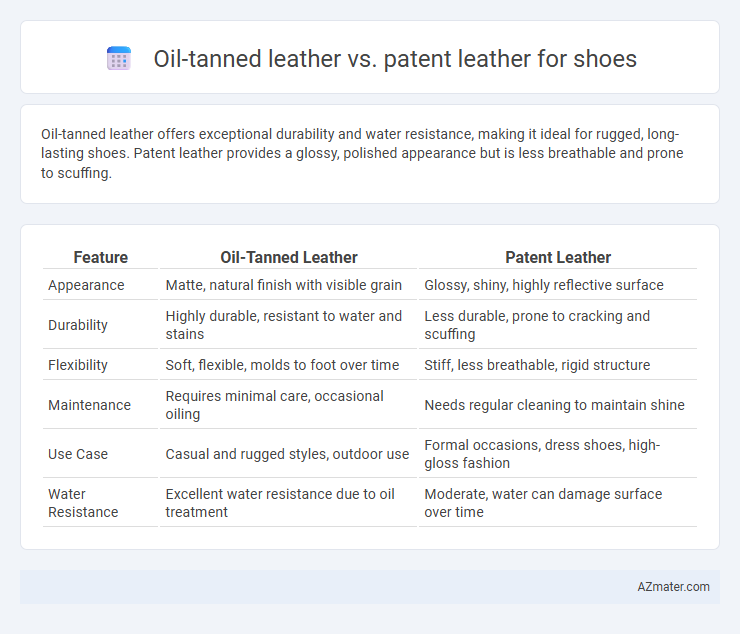Oil-tanned leather offers exceptional durability and water resistance, making it ideal for rugged, long-lasting shoes. Patent leather provides a glossy, polished appearance but is less breathable and prone to scuffing.
Table of Comparison
| Feature | Oil-Tanned Leather | Patent Leather |
|---|---|---|
| Appearance | Matte, natural finish with visible grain | Glossy, shiny, highly reflective surface |
| Durability | Highly durable, resistant to water and stains | Less durable, prone to cracking and scuffing |
| Flexibility | Soft, flexible, molds to foot over time | Stiff, less breathable, rigid structure |
| Maintenance | Requires minimal care, occasional oiling | Needs regular cleaning to maintain shine |
| Use Case | Casual and rugged styles, outdoor use | Formal occasions, dress shoes, high-gloss fashion |
| Water Resistance | Excellent water resistance due to oil treatment | Moderate, water can damage surface over time |
Introduction to Oil-Tanned and Patent Leather
Oil-tanned leather, known for its rich texture and water-resistant properties, is created by infusing leather with oils and waxes, enhancing durability and softness ideal for rugged yet stylish shoes. Patent leather features a high-gloss finish achieved through a coating process, offering a sleek, polished look favored in formal footwear for its eye-catching shine and easy maintenance. Both materials serve distinct aesthetic and functional purposes in shoe manufacturing, catering to different fashion and practical needs.
Defining Oil-Tanned Leather
Oil-tanned leather is crafted by infusing natural oils into its fibers, producing a durable, water-resistant material with a supple texture ideal for shoes. Compared to patent leather, which features a glossy, lacquered finish, oil-tanned leather offers a matte, rugged appearance that enhances with age and wear. This type of leather excels in durability and weather resistance, making it a preferred choice for shoes requiring both functionality and a natural aesthetic.
What is Patent Leather?
Patent leather is a type of coated leather characterized by its high-gloss, mirror-like finish achieved through a lacquer or varnish coating. Unlike oil-tanned leather, which is known for its durability and natural texture, patent leather emphasizes a sleek, polished appearance ideal for formal footwear. The coating on patent leather creates a smooth, resistant surface that repels moisture and stains but may be prone to cracking over time if not properly maintained.
Key Differences: Appearance and Finish
Oil-tanned leather showcases a rich, matte finish with a natural, rugged texture that develops a unique patina over time, enhancing its character and durability. Patent leather features a smooth, glossy surface achieved through a coating process, offering a sleek, highly reflective appearance ideal for formal footwear. The key difference lies in oil-tanned leather's breathable, flexible quality versus patent leather's rigid, water-resistant finish, impacting both aesthetic appeal and functionality in shoe design.
Durability and Longevity Comparison
Oil-tanned leather offers superior durability and longevity due to its natural oils, which enhance water resistance and maintain flexibility over time, making it ideal for robust, long-lasting shoes. Patent leather, while prized for its high-gloss finish and stylish appearance, is more susceptible to cracking and scuffing, reducing its lifespan compared to oil-tanned leather. For shoes requiring extended wear and resilience, oil-tanned leather provides a distinct advantage in maintaining structural integrity and durability.
Comfort and Flexibility in Shoes
Oil-tanned leather offers superior comfort and flexibility in shoes due to its natural oils that keep the material soft and supple, allowing it to mold to the foot over time. Patent leather, characterized by its glossy, coated finish, provides less flexibility and can feel stiffer, potentially causing discomfort during extended wear. The breathability and durability of oil-tanned leather make it ideal for those prioritizing long-term comfort and adaptability in footwear.
Maintenance and Care Requirements
Oil-tanned leather shoes require regular conditioning with specialized leather oils or waxes to maintain their supple texture and water resistance, while patent leather demands frequent cleaning with a damp cloth to preserve its glossy finish and avoid cracking. Oil-tanned leather benefits from occasional re-oiling to prevent drying and cracking, whereas patent leather is prone to surface scratches and discoloration if exposed to abrasive materials or harsh chemicals. Proper storage in a cool, dry place with shoe trees is essential for both types to retain shape and prolong lifespan.
Ideal Uses for Each Leather Type
Oil-tanned leather excels in rugged environments and outdoor activities due to its durability, water resistance, and ability to develop a rich patina over time, making it ideal for boots, work shoes, and casual footwear. Patent leather, with its glossy, smooth finish and sleek appearance, is best suited for formal shoes, dress shoes, and occasions requiring polished, sophisticated style. Both leathers serve distinct purposes, with oil-tanned leather prioritizing functionality and longevity, while patent leather emphasizes aesthetics and elegance.
Price and Value Considerations
Oil-tanned leather shoes generally command a higher price due to their durability and rich, natural finish that improves with age, offering long-term value for those seeking rugged, moisture-resistant footwear. Patent leather shoes tend to be less expensive initially but offer limited durability, making them better suited for occasional wear where glossy appearance is prioritized over longevity. Choosing between oil-tanned and patent leather ultimately depends on whether the buyer values initial cost savings or lasting quality and aging character.
Choosing the Best Leather for Your Shoes
Oil-tanned leather offers exceptional durability and water resistance, making it ideal for rugged, everyday shoes that require long-lasting performance and a natural, matte finish. Patent leather provides a glossy, polished look suitable for formal or dress shoes, but it is less breathable and more prone to scuffing than oil-tanned leather. Choosing the best leather depends on your lifestyle needs: select oil-tanned leather for robustness and weather protection or patent leather for sleek style and elegance.

Infographic: Oil-tanned leather vs Patent leather for Shoe
 azmater.com
azmater.com